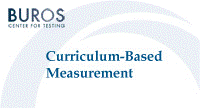Buros-Nebraska Series on Measurement and Testing

Curriculum-Based Measurement
Date of this Version
1993
Document Type
Article
Citation
Curriculum-Based Measurement, edited by Jack J. Kramer (Lincoln, NE: Buros Institute of Mental Measurements, 1993).
Abstract
The very fact that curriculum-based assessment (CBA) forms the basis of a topic-driven conference at the center of American educational and psychological measurement (i.e., the Buros Institute) is testimony that the strategies are receiving a substantial amount of professional attention. Although debate continues regarding to whom and when the term curriculum-based assessment should be ascribed (Coulter, 1988), without question, its prominence has grown considerably in the last 10 years. Within the last 5 years, school psychology and special education have seen their flagship journals, School Psychology Review and Exceptional Children, devote special volumes to CBA. National organizations such as the National Association of School Psychologists (NASP) and the National Coalition of Advocates for Children (NCAS) have encouraged the use of CBA for decision making with handicapped students (NASP/NCAS, 1985). Interpretations of recent litigation also have been construed to suggest use of CBA strategies (Reschly, Kicklighter, & McKee, 1988a; Reschly, Kicklighter, & McKee, 1988b; Reschly, Kicklighter, & McKee, 1988c).
This chapter seeks to examine CBA's future as an assessment strategy from a perspective of school systems change (Sarason, 1982) and adoption of technological innovations (Rogers, 1983). To understand the school-change process, Hall and Hord (1984) maintain that change agents must consider the perspective of the implementors of the innovation. Using what they call a Concerns-Based Adoption Model (CBAM), Hall and Hord (1984) propose that implementors' concerns about change progress through a sequence of seven stages: (a) awareness, (b) informational, (c) personal, (d) management, (e) consequence, (f) collaboration, and (g) refocusing. An individual's concerns about innovation are not confined to anyone stage, however. The seven concerns are divided into four general categories. Awareness is categorized as an unrelated concern, where the implementor generally is only somewhat cognizant of the innovation. Informational and personal concerns are self concerns, where the implementors' reactions are centered primarily on how the innovation affects them. Management is a task concern, where consideration is given to how best to use the innovation. Consequence, collaboration, and refocusing are impact concerns, where attention is shifted to the potential effects of the innovation on clients.
Each stage of Hall and Hord's CBAM model requires a different approach to influencing and facilitating the change process. At best, we believe the field of education, and more specifically special education and school psychology, is currently at the awareness and informational stages with respect to the implementation of CBA. Professionals are being exposed to CBA and are gathering information. We believe that an analysis of the future of CBA will require us to examine first the extent of professionals' knowledge regarding CBA. We will accomplish this task in two ways. First, we will identify briefly the major innovators in CBA and where their information is being disseminated. Second, we will analyze the major critiques of CBA (Lentz & Shapiro, 1986; Lombard, 1988a; Lombard, 1988b; Taylor, Willits, & Richards, 1988) under the premise that one gains an understanding of what is being communicated by how accurately it is described by others than the innovators themselves.
Included in
Curriculum and Instruction Commons, Educational Assessment, Evaluation, and Research Commons


Comments
Copyright © 1993 by Buros Institute of Mental Measurements. Digital Edition Copyright © 2012 Buros Center for Testing. This book may be downloaded, saved, and printed by an individual for their own use. No part of this book may be re-published, re-posted, or redistributed without written permission of the holder of copyright.